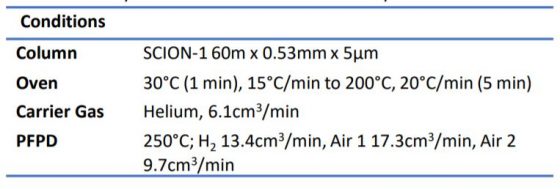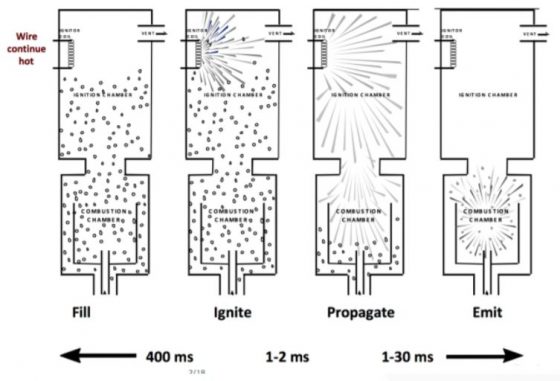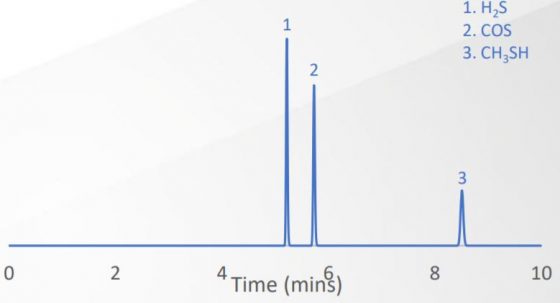Determination of Sulphur Gases in Natural Gas
Introduction
The presence of sulphur compounds in natural gas is undesirable since many of these compounds possess unpleasant odours, are unstable, corrosive and poisonous to industrial catalysts. ASTM D6228 is the standard test method for the determination of sulphur compounds in natural gas by GC-PFPD (pulsed flame photometric detector).
In the analysis of sulphur containing gases in natural gas, it is vital that complete separation of methane is achieved whilst also avoiding adsorption of sulphur compounds on the reactive surfaces of the analytical system.
This application note focuses on the chromatographic aspects of the system. Three sulphur gases; hydrogen sulphide, carbonyl sulphide and methyl mercaptan were isolated from natural gas components using a thick PDMS column in combination with a PFPD.
Experimental
The sample was introduced directly into the capillary column using an automated 6-port Valco gas sampling valve equipped with a 250μL deactivated metal loop. The analytical conditions of the instrumentation can be found in Table 1.

Table 1. Analytical conditions of the GC PFPD system
PFPD Operation
The PFPD houses two chambers. Ignition from a continuous igniter filament takes place in the ignition chamber and the flame propagates to a quartz tube in the combustion chamber to which a light pipe and photomultiplier tube and filter is connected. Hydrogen and air flow to the PFPD at rates such that a pulsing background, chemiluminescent emissions associated with the hydrogen rich flame emit over a period of 3-4 ms while emissions from the S2 species emit from 4 to 16ms.
This delayed emission is monitored by a delayed electrometer gate where gate delay and width are optimised for the sulphur emissions. Since the flame background is significantly eliminated, the sulphur signal is optimised.
A detectivity of 1pgS/s and a selectivity of 106 S/C are obtained and equimolar response is obtained irrespective of sulphur compound identity. Figure 1 details a schematic operation of the PFPD.

Fig 1. Schematic operation of the PFPD
Results
Table 2 shows the optimised separation under the conditions mentioned in the text. The sulphur species are completely separated from methane and the response is equimolar to sulphur.

Table 2. Separation of hydrogen sulphide and methyl mercaptan
Figure 2 shows the chromatogram of the PFPD analysis of H2S, COS and CH3SH.

Fig 2. H2S, COS and CH3SH in natural gas
ASTM method 6228 requires the retention time repeatability for the analytes of interest to be at or below 0.05 minutes. Four consecutive runs of the standard in natural gas were made with the following precisions: H2
S 0.005, COS 0.005 and CH3SH 0.004min. The PFPD provides equimolar response to sulphur independent of the compound in this is
exists. Therefore, calibration factors for different components, based on sulphur content, are equal.
Conclusion
Following the guidelines of ASTM method 6228, sulphur gases may be resolved from major natural gas components on a long, thick film capillary column of 0.53mm internal diameter. Initial column temperature is critical to this separation. Excellent retention precision is obtained with the PFPD providing selective and equimolar response for sulphur compounds.
*The natural gas analyser can be configured with chemiluminescence detection for the determination of sulphur in natural gas as specified by ASTM D5504.
Download Application Note
Download the complete Application Note: Determination of Sulphur Gases in Natural Gas
SCION Gas Chromatography Analyser
A SCION Gas Chromatography Analyser was used to conduct this research. Providing excellent solutions for Environmental, Oil and Gas and Chemical industries, find out more about Scion GC Analysers.
If you would like to speak to a member of our team for more information, please don’t hesitate to get in touch. Or to stay in the loop regarding future research and articles from SCION Instruments, why not join us on social media and sign up to our eNewsletter today?
